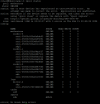So currently, I have a ZFS RaidZ10 array, that is just ridiculous in complexity for managing:

Unfortunately, I nearly had 2 simultaneous disk failures in the same RAIDZ1 sub-dev, which would have resulted in the loss of the entire 55TB array. So I backed up my files to a different system, and am going to rebuild the array. One thing is that it had pretty poor performance:

So as I've studied, I've found that I should have used 6 drives independently, I thought using sets of 5 disks per vdev was sufficient (also apparently 5 disks is inefficient in a raidz1 configuration?), but I guess the whole pool takes the performance hit when you raid across it, even if it's a striped raid0.
I'm debating about breaking up the pool into either: 2 raidz2 pools with 8 disks each, or 3 raidz1 pools with 6 disks each. I'm also going to take additional steps to optimize the layout of the array (originally I made no real optimizations), since these are mostly jpg/raw photos, videos, and backup files: ashift=12, recordsize=1M, atime=off, and xattr=sa.
Does anyone have any recommendations on how best to organize the pool? They're 5TB spinning rust drives, and I have a separate pair of SSDs for ZIL and L2ARC. I don't plan on retaining the hotspare in this setup, since the loss of one array won't result in the loss of all my data, and the scare made me get a USB backup drive to ensure my critical data doesn't die. I'm also going to set up smartd email notifications so I am notified of failures sooner, and rebuilding a 6-8 disk array will be substantially faster than rebuilding a 15 disk array.
So yes, recommendations, suggestions, and thoughts would be appreciated!

Unfortunately, I nearly had 2 simultaneous disk failures in the same RAIDZ1 sub-dev, which would have resulted in the loss of the entire 55TB array. So I backed up my files to a different system, and am going to rebuild the array. One thing is that it had pretty poor performance:

So as I've studied, I've found that I should have used 6 drives independently, I thought using sets of 5 disks per vdev was sufficient (also apparently 5 disks is inefficient in a raidz1 configuration?), but I guess the whole pool takes the performance hit when you raid across it, even if it's a striped raid0.
I'm debating about breaking up the pool into either: 2 raidz2 pools with 8 disks each, or 3 raidz1 pools with 6 disks each. I'm also going to take additional steps to optimize the layout of the array (originally I made no real optimizations), since these are mostly jpg/raw photos, videos, and backup files: ashift=12, recordsize=1M, atime=off, and xattr=sa.
Does anyone have any recommendations on how best to organize the pool? They're 5TB spinning rust drives, and I have a separate pair of SSDs for ZIL and L2ARC. I don't plan on retaining the hotspare in this setup, since the loss of one array won't result in the loss of all my data, and the scare made me get a USB backup drive to ensure my critical data doesn't die. I'm also going to set up smartd email notifications so I am notified of failures sooner, and rebuilding a 6-8 disk array will be substantially faster than rebuilding a 15 disk array.
So yes, recommendations, suggestions, and thoughts would be appreciated!

